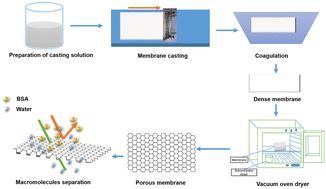Fabrication of a polyethersulfone/polyethyleneimine porous membrane for sustainable separation of proteins in water media
Abstract
This paper aims to establish a new sustainable membrane with antifouling properties by developing a structured porous membrane with a honeycomb-like surface fabricated by blending polymers and additives via immersion precipitation and using a thermally induced phase inversion method coupled with exposure time to vapor. The hydrophilic properties, surface charge, and pore size of the membrane were dependent on controlling the blending ratio of polyethersulfone (PES), polyethyleneimine (PEI), and polyvinylpyrrolidone (PVP). The properties of the membranes were characterized, including physical properties, morphology, contact angle, mechanical properties, porosity, and pore size distribution. The membrane filtration performance was evaluated by examining the water permeation, antifouling, and hydrophilic properties of the membranes. The hydrophilic nature of the PES/PEI membrane increased the filtration performance and created a smooth surface that exhibited excellent antifouling ability. Finally, the separation capability of the membranes was evaluated using bovine serum albumin (BSA) and Angelica gigas Nakai (AGN) root solutions. An almost 99.9% rejection rate was achieved for BSA and AGN at 1 bar pressure. The optimized membrane outperforms the commercial membrane with analogous characteristics on both the water flux and molecular weight cut-off (MWCO) of polyethylene glycol (PEG). Due to the controlled pore size (0.0032 to 0.0041 μm) of the honeycomb-like surface, it may be possible to separate pharmacodynamic macromolecules (such as berberine, baicalin, geniposide, and palmatine) for future applications.



 Please wait while we load your content...
Please wait while we load your content...